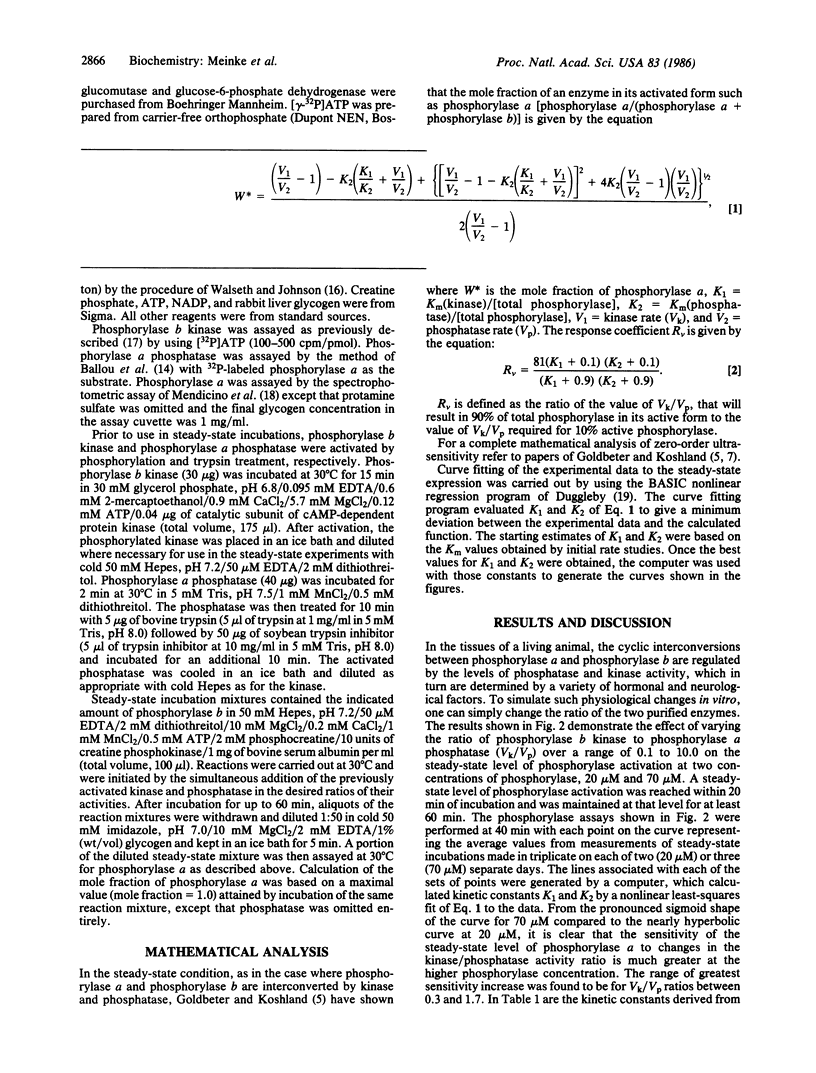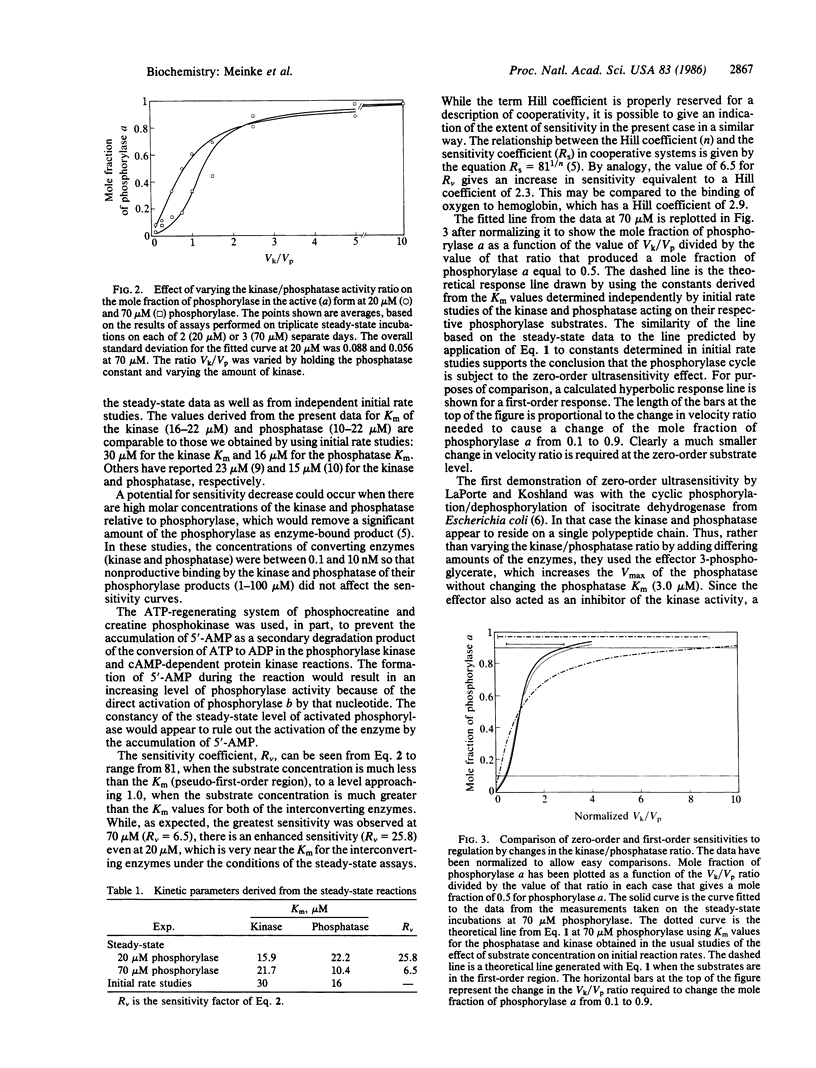Abstract
The activity of glycogen phosphorylase (1,4-alpha-D-glucan:orthophosphate alpha-D-glucosyltransferase, EC 2.4.1.1) is controlled by a cyclic phosphorylation-dephosphorylation process through the action of the interconverting enzymes, phosphorylase b kinase (ATP:phosphorylase-b phosphotransferase, EC 2.7.1.38) and phosphorylase a phosphatase (phosphorylase a phosphohydrolase, EC 3.1.3.17). In muscle tissue, the combined concentration of the activated (phospho-) form, phosphorylase a, and the nonactivated (dephospho-) form, phosphorylase b, is substantially greater than the Km of either of the interconverting enzymes for its phosphorylase substrate. It has been predicted that, under such a set of conditions, a sensitivity amplification will occur for phosphorylase regulation due to the zero-order ultrasensitivity effect [LaPorte, D. C. & Koshland, D. E., Jr. (1983) Nature (London) 305, 286-290]. The sensitivity amplification will enhance the responsiveness of the phosphorylase interconversion cycle to changes in the ratio of activities of the kinase to phosphatase. We have studied the cyclic interconversion process using purified muscle enzymes in steady-state reactions and found that there is an enhancement in the control sensitivity of the process due to the zero-order ultrasensitivity effect. The potential for the in vivo enhancement of sensitivity in glycogen degradation by this effect is discussed.
Full text
PDF



Selected References
These references are in PubMed. This may not be the complete list of references from this article.
- Ballou L. M., Brautigan D. L., Fischer E. H. Subunit structure and activation of inactive phosphorylase phosphatase. Biochemistry. 1983 Jul 5;22(14):3393–3399. doi: 10.1021/bi00283a014. [DOI] [PubMed] [Google Scholar]
- Brautigan D. L., Khatra B. S., Soderling T. R., Fischer E. H. Dephosphorylation of skeletal muscle phosphorylase, glycogen synthase, and phosphorylase kinase beta-subunit by a Mn2+-activated protein phosphatase. Arch Biochem Biophys. 1982 Nov;219(1):228–235. doi: 10.1016/0003-9861(82)90153-9. [DOI] [PubMed] [Google Scholar]
- Cohen P. Protein phosphorylation and the control of glycogen metabolism in skeletal muscle. Philos Trans R Soc Lond B Biol Sci. 1983 Jul 5;302(1108):13–25. doi: 10.1098/rstb.1983.0034. [DOI] [PubMed] [Google Scholar]
- Cohen P. The subunit structure of rabbit-skeletal-muscle phosphorylase kinase, and the molecular basis of its activation reactions. Eur J Biochem. 1973 Apr 2;34(1):1–14. doi: 10.1111/j.1432-1033.1973.tb02721.x. [DOI] [PubMed] [Google Scholar]
- Cox D. E., Edstrom R. D. Inhibition by calmodulin of the cAMP-dependent protein kinase activation of phosphorylase kinase. J Biol Chem. 1982 Nov 10;257(21):12728–12733. [PubMed] [Google Scholar]
- Dombrádi V. Structural aspects of the catalytic and regulatory function of glycogen phosphorylase. Int J Biochem. 1981;13(2):125–139. doi: 10.1016/0020-711x(81)90147-6. [DOI] [PubMed] [Google Scholar]
- Duggleby R. G. A nonlinear regression program for small computers. Anal Biochem. 1981 Jan 1;110(1):9–18. doi: 10.1016/0003-2697(81)90104-4. [DOI] [PubMed] [Google Scholar]
- Goldbeter A., Koshland D. E., Jr An amplified sensitivity arising from covalent modification in biological systems. Proc Natl Acad Sci U S A. 1981 Nov;78(11):6840–6844. doi: 10.1073/pnas.78.11.6840. [DOI] [PMC free article] [PubMed] [Google Scholar]
- Goldbeter A., Koshland D. E., Jr Sensitivity amplification in biochemical systems. Q Rev Biophys. 1982 Aug;15(3):555–591. doi: 10.1017/s0033583500003449. [DOI] [PubMed] [Google Scholar]
- Ingebritsen T. S., Stewart A. A., Cohen P. The protein phosphatases involved in cellular regulation. 6. Measurement of type-1 and type-2 protein phosphatases in extracts of mammalian tissues; an assessment of their physiological roles. Eur J Biochem. 1983 May 2;132(2):297–307. doi: 10.1111/j.1432-1033.1983.tb07362.x. [DOI] [PubMed] [Google Scholar]
- Koshland D. E., Jr, Goldbeter A., Stock J. B. Amplification and adaptation in regulatory and sensory systems. Science. 1982 Jul 16;217(4556):220–225. doi: 10.1126/science.7089556. [DOI] [PubMed] [Google Scholar]
- Krebs E. G. Phosphorylation and dephosphorylation of glycogen phosphorylase: a prototype for reversible covalent enzyme modification. Curr Top Cell Regul. 1981;18:401–419. doi: 10.1016/b978-0-12-152818-8.50030-x. [DOI] [PubMed] [Google Scholar]
- LaPorte D. C., Koshland D. E., Jr Phosphorylation of isocitrate dehydrogenase as a demonstration of enhanced sensitivity in covalent regulation. Nature. 1983 Sep 22;305(5932):286–290. doi: 10.1038/305286a0. [DOI] [PubMed] [Google Scholar]
- Nelson N. C., Taylor S. S. Differential labeling and identification of the cysteine-containing tryptic peptides of catalytic subunit from porcine heart cAMP-dependent protein kinase. J Biol Chem. 1981 Apr 25;256(8):3743–3750. [PubMed] [Google Scholar]
- Resink T. J., Hemmings B. A., Tung H. Y., Cohen P. Characterisation of a reconstituted Mg-ATP-dependent protein phosphatase. Eur J Biochem. 1983 Jun 15;133(2):455–461. doi: 10.1111/j.1432-1033.1983.tb07485.x. [DOI] [PubMed] [Google Scholar]
- Shacter E., Chock P. B., Stadtman E. R. Energy consumption in a cyclic phosphorylation/dephosphorylation cascade. J Biol Chem. 1984 Oct 10;259(19):12260–12264. [PubMed] [Google Scholar]
- Shacter E., Chock P. B., Stadtman E. R. Regulation through phosphorylation/dephosphorylation cascade systems. J Biol Chem. 1984 Oct 10;259(19):12252–12259. [PubMed] [Google Scholar]
- Silberman S. R., Speth M., Nemani R., Ganapathi M. K., Dombradi V., Paris H., Lee E. Y. Isolation and characterization of rabbit skeletal muscle protein phosphatases C-I and C-II. J Biol Chem. 1984 Mar 10;259(5):2913–2922. [PubMed] [Google Scholar]
- Tabatabai L. B., Graves D. J. Kinetic mechanism and specificity of the phosphorylase kinase reaction. J Biol Chem. 1978 Apr 10;253(7):2196–2202. [PubMed] [Google Scholar]
- Walseth T. F., Johnson R. A. The enzymatic preparation of [alpha-(32)P]nucleoside triphosphates, cyclic [32P] AMP, and cyclic [32P] GMP. Biochim Biophys Acta. 1979 Mar 28;562(1):11–31. doi: 10.1016/0005-2787(79)90122-9. [DOI] [PubMed] [Google Scholar]


